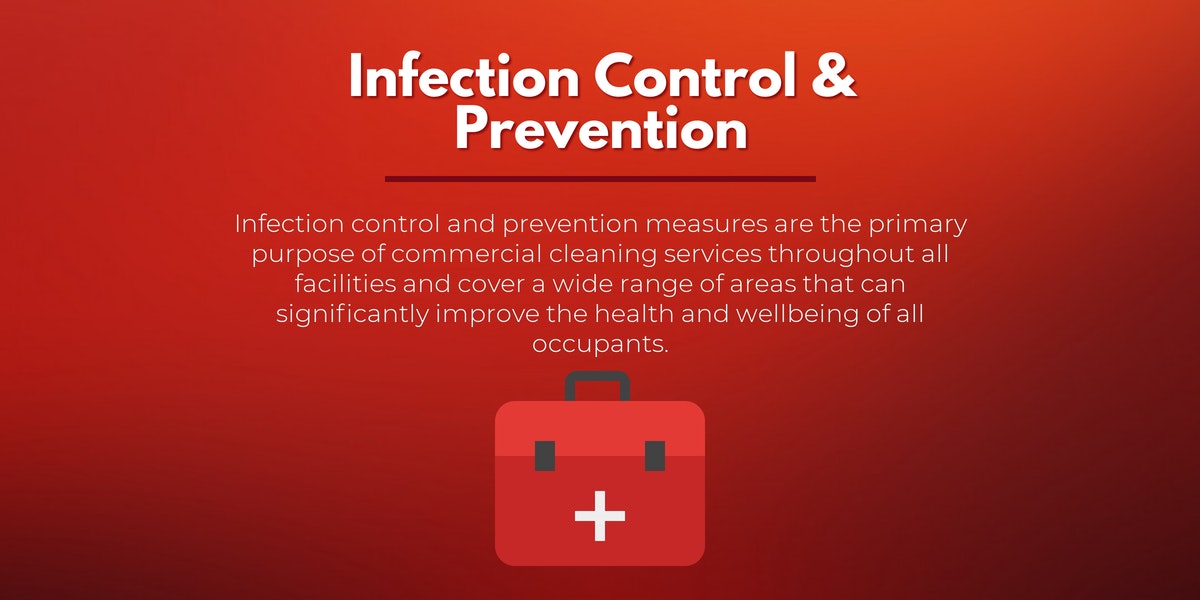Infection control and prevention measures are the primary purpose of commercial cleaning services throughout all facilities and cover a wide range of areas that can significantly improve the health and wellbeing of all occupants.

Infection Control & Prevention Measures for Schools and Businesses
Infection prevention and control is something that most business managers and school administrators only think about during cold and flu season, or if they have to visit a doctor's office or medical facility, unaware of the dangerous germs and bacteria that surround us every day, such as:
- E.coli.
- Salmonella
- C.diff.
- Norovirus.
- Listeria, and;
- Staph.
These germs are commonly passed from person-to-surface and then from surface-to-person due to two factors:
- An absence of proper handwashing, and;
- Insufficient cleaning and disinfection procedures for hot spot surfaces.
Improving those criteria and combining them with a clean for health first approach that focuses on custodial practices that are safe for people, pets, and the environment, is a proven method for:
- Increasing profits.
- Improving attendance, grades, and cognitive functions.
- Decreasing dangerous volatile organic compounds (VOCs) that have been linked to sick building syndrome and the onset of asthma or asthma-like symptoms.
- Improving organizational public image, and;
- Appealing to emerging demographics.
General Infection Prevention & Control Tips
Outside of a healthcare setting, the following general tips for maintaining a high-quality infection control and prevention initiatitive combined with a clean for health first approach should consist of:
- Hand hygiene.
- Cleaning and disinfection.
- Respiratory hygiene, and;
- Waste disposal.
Hand Hygiene
Most people don't wash their hands correctly, or at all, specifically after using the restroom.
This leads to a host of health-related challenges involving the rapid spread of dangerous, sometimes deadly, germs throughout a facility, and the need for constant vigilance on the part of the custodial staff and building occupants.
As a general rule of thumb:
- Scrub your hands with warm water and soap for twenty seconds.
- Foaming soap is best.
- Make sure to get between the fingers, under the nails, on top of the hands, and the thumbs.
- Rinse downward into the sink with warm water.
- Dry your hands with paper towels and avoid air-blown hand dryers.
- Disinfect with hand sanitizer upon exiting the restroom.
- Make sure to always wash after using the restroom and prior to eating.
Cleaning & Disinfection
Conventional cleaning and disinfection strategies have previously revolved around look and smell, as opposed to the efficacy of the initiative, or the consequences of its long-term implementation.
Cleaning for health involves focused efforts on the use of:
- Sustainable practices.
- Biodegradable and non-toxic chemicals, and;
- Equipment that manages the use of cleaning products and water more effectively.
This is accomplished by:
- Identifying primary areas of concern, such as high-traffic restrooms, dining areas, and shared work spaces.
- Cleaning and disinfecting regularly with certified green cleaning products and microfiber equipment.
- Implementing cross-contamination control measures, and;
- Providing regular occupants with wipes to clean off their desk and electronic equipment.
Respiratory Hygiene
Coughing and sneezing can spread germs into the air that remain for several hours and eventually settle on a surface where they can remain infectious for several days.
Adhering to socially acceptable norms, such as:
- Covering your mouth or nose when coughing or sneezing.
- Couging or sneezing into your elbow or a tissue.
- Disposing of the tissue in the trash immediately after, and;
- Washing your hands before touching anything else.
Can have a dramatic impact on the prevention of the spread of germs throughout a facility.
Waste Disposal
Dirty towels, used tissues, and contaminated water used in the cleaning and disinfection process must be properly disposed of in a manner that reduces contact with building occupants on a regular basis.
Trash receptacles should be:
- Leak free.
- Changed often.
- Lined with plastic trash bags, and;
- Cleaned and disinfected, inside and out, regularly.
Waste water should be:
- Dumped only in authorized sinks or drains, and;
- Handled with care to avoid cross-contamination.
In both instances, proper protective equipment should always be worn to avoid coming into contact with germs and spreading them throughout the facility or to other occupants.
References & Resources
- Infection Control and Prevention - Standard Precautions
- 10 Best Strategies for Infection Prevention and Control
- Infection Control
- Resources for Infection Control and Prevention
Takeaway
A high-quality infection prevention and control initiative combined with a clean for health first approach is one of the best methods for reducing issues and costs directly tied to occupant illness in schools and the workplace.
Outsourcing your needs to an experienced vendor is a proven method for rapidly onboarding these beneficial programs while reducing management overhead and costly headaches.
If you would like to find out more about the cost-saving advantages to outsourcing your facilities infection and prevention control initiatives, contact us today for a free quote!
In Bakersfield CA, call (661) 437-3253
In Fresno CA, call (559) 206-1059
In Valencia CA, or Santa Clarita CA, call (661) 437-3253

